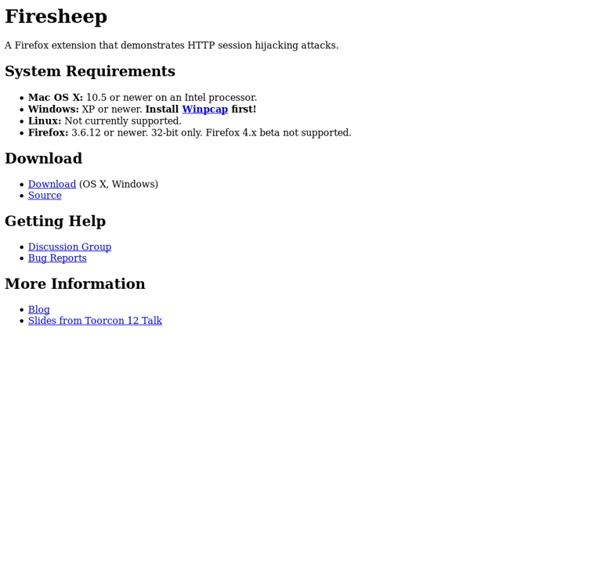



http://codebutler.github.io/firesheep/
Malicious Linux Commands - From (This article was originally published in Ubuntu Forums but was removed there. Ubuntuguide feels that knowledge about these risks is more important than any misguided attempts to "protect the public" by hiding their potential dangers or protect the (K)Ubuntu/Linux image. Firesheep The extension was created as a demonstration of the security risk of session hijacking vulnerabilities to users of web sites that only encrypt the login process and not the cookie(s) created during the login process.[3] It has been warned that the use of the extension to capture login details without permission would violate wiretapping laws and/or computer security laws in some countries. Despite the security threat surrounding Firesheep, representatives for Mozilla Add-ons have stated that it would not use the browser's internal add-on blacklist to disable use of Firesheep, as the blacklist has only been used to disable spyware or add-ons which inadvertently create security vulnerabilities, as opposed to attack tools (which may legitimately be used to test the security of one's own systems).[4] Note that even if they did, it wouldn't actually prevent anyone from using Firesheep, as Firefox contains a hidden setting to disable this blacklist.[5] Countermeasures[edit]
Essential Wireless Hacking Tools By Daniel V. Hoffman, CISSP, CWNA, CEH Anyone interested in gaining a deeper knowledge of wireless security and exploiting vulnerabilities will need a good set of base tools with which to work. Fortunately, there are an abundance of free tools available on the Internet. This list is not meant to be comprehensive in nature but rather to provide some general guidance on recommended tools to build your toolkit.
Google Dorks cache: If you include other words in the query, Google will highlight those words within the cached document. For instance, [cache:www.google.com web] will show the cached content with the word “web” highlighted. This functionality is also accessible by clicking on the “Cached” link on Google’s main results page. The query [cache:] will show the version of the web page that Google has in its cache. For instance, [cache:www.google.com] will show Google’s cache of the Google homepage. Attack Tools Sometimes, the best defense is a good offense. Bishop Fox’s attack tools for Google Hacking level the playing field by allowing our clients to find information disclosures and exposed vulnerabilities before others do. Arm yourself with our arsenal of attack tools that leverage Google, Bing, and other popular search engines.
ActivePerl is Perl for Windows, Mac, Linux, AIX, HP-UX & Solaris ActivePerl Business and Enterprise Editions feature our precompiled, supported, quality-assured Perl distribution used by millions of developers around the world for easy Perl installation and quality-assured code. When you're using Perl on production servers or mission-critical applications, ActivePerl Business and Enterprise Editions offer significant time savings over open source Perl for installing, managing, and standardizing your Perl . If you are using ActivePerl for production, redistribution, on terminal servers, for thin client for app deployment (i.e. on MS Terminal Services, Citrix XenApp or File Servers), or for use on HP-UX/AIX/Solaris then ActivePerl Community Edition is not the right license for you. Please contact us for Business Edition or Enterprise Edition options. Not sure which edition is right for you?
Google hacking Basics[edit] The following search query will locate all websites that have the words "admbook" and "version" in the title of the website. It also checks to ensure that the web page being accessed is a PHP file. intitle:admbook intitle:version filetype:php One can even retrieve the username and password list from Microsoft FrontPage servers by inputting the given microscript in Google search field:
Unicode fun All Unicode characters in the range 0x0000-0xFFFF which have a visible glyph in Windows's Arial font. Copy-paste to build fun smileys ! ! " # $ % & ' ( ) * + , - . / 0 1 2 3 4 5 6 7 8 9 : ; < = > ? Hidden iframe injection attacks [Updated on October 27, 2009 with new a version of the script] It is a shame that after all those posts about security, some of my websites were under attack today. Shoban and Anand emailed me about this today morning (Thanks guys) and I tried to understand what was going on. To my utter disbelief more than 10 websites hosted in the same server were affected by the attack.
Password crackers SecTools.Org: Top 125 Network Security Tools For more than a decade, the Nmap Project has been cataloguing the network security community's favorite tools. In 2011 this site became much more dynamic, offering ratings, reviews, searching, sorting, and a new tool suggestion form . This site allows open source and commercial tools on any platform, except those tools that we maintain (such as the Nmap Security Scanner , Ncat network connector , and Nping packet manipulator ). We're very impressed by the collective smarts of the security community and we highly recommend reading the whole list and investigating any tools you are unfamiliar with. SecurityXploit: Pentest web-sorrow - Linux Am Saturday, 19. May 2012 im Topic 'Pentest' A perl based tool used for checking a Web server for misconfiguration, version detection, enumeration, and server information. I will build more Functionality in the future. what is's NOT: Vulnerably scanner, inspection proxy, DDoS tool, exploitation framework. It's entirely focused on Enumeration and collecting Info on the target server
Short Film of the Day: Stuxnet: Anatomy of a Computer Virus Why Watch? Because we should challenge how we define a film. Most of the shorts featured in this column are either easy to spot as stories or completely experimental. Even when a documentary short is in the spotlight, it tells a clear tale of people doing things. This short, is none of those things. Stuxnet: Anatomy of a Computer Virus is an informational film made entirely of voice over narration and motion graphics.